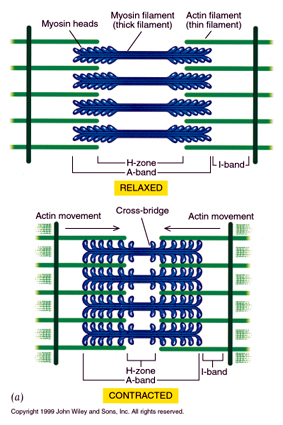| Home | Background |
Levers |
Trade-Offs | Statics |
Mysteries | Bibliography |
Background

Muscles provide the
forces necessary for moving, lifting, or even just standing still.
Muscles allow us to smile, dance,
sit, or carry heavy boxes on moving day. Muscles even allow for the
seemingly amazing feats of an ant carrying a large seed or a flea
leaping into the air about one hundred times its height.

What are
Muscles and How do they Generate a Force?
Any
muscle, such as your bicep, consist of bundles of muscle fiber which
contain myofibrils. The myofibrils are made sarcomeres, which are made
of sections of the protein filaments
actin and myosin. These two filaments use the energy stored in the
molecular bonds of adenosine triphosphate (ATP) to create a
"power stroke." In the power stroke, a chemical bond creates a cross
bridge is formed between actin and myosin, and the two fibers are
pulled past each other.
The number of cross bridges corresponds to the tension produced.
These molecular interactions provide the mechanical force of muscle tension.
The number of cross bridges corresponds to the tension produced.
These molecular interactions provide the mechanical force of muscle tension.
In an Isometric Contraction, the
muscle tension is equal to an external force and the muscle stays the
same length. This is an example of Static Equilibrium.
In an Isotonic Contraction, the muscle tension is
greater than an external force, and the muscle contracts.
Only about 25% of the energy required in a contraction actually goes into contracting the muscle. (http://fig.cox.miami.edu/~cmallery/150/neuro/contraction.jpg)
This is about the same efficiency of a combustion engine.
Only about 25% of the energy required in a contraction actually goes into contracting the muscle. (http://fig.cox.miami.edu/~cmallery/150/neuro/contraction.jpg)
This is about the same efficiency of a combustion engine.
http://w3b.phys.chs.nihon-u.ac.jp/~chaen/image/ActinMyosin.GIF
(Edited by Kelsey Alexander)